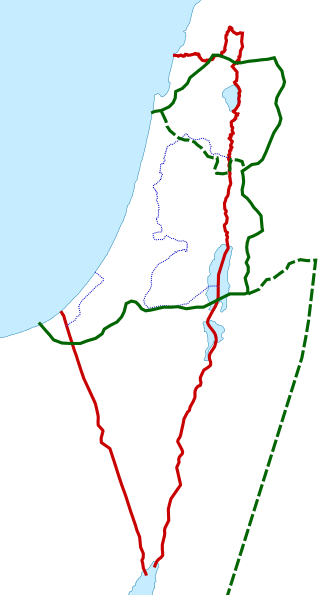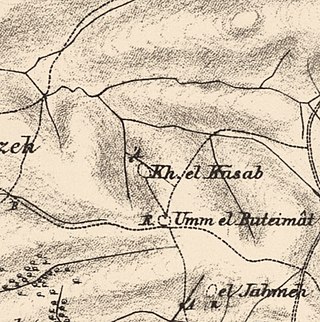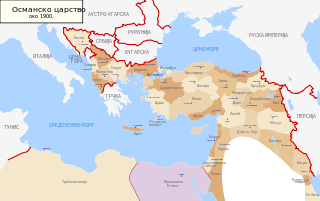Related Research Articles

Colonialism is the pursuing, establishing and maintaining of control and exploitation of people and of resources by a foreign group of people. The colonizer monopolizes political power and holds the conquered society and its people to be inferior to their conqueror in legal, administrative, social, cultural, or biological terms. While frequently advanced as an imperialist regime, colonialism can also take the form of settler colonialism, whereby colonial settlers invade and occupy territory to permanently replace an existing society with that of the colonizers, possibly towards a genocide of native populations.

The Ottoman Empire, historically and colloquially known as the Turkish Empire, was an imperial realm that spanned much of Southeast Europe, West Asia, and North Africa from the 14th to early 20th centuries; it also controlled parts of southeastern Central Europe, between the early 16th and early 18th centuries.
Superpower describes a state or supranational union that holds a dominant position characterized by the ability to exert influence or project power on a global scale. This is done through the combined means of economic, military, technological, political, and cultural strength as well as diplomatic and soft power influence. Traditionally, superpowers are preeminent among the great powers. While a great power state is capable of exerting its influence globally, superpowers are states so influential that no significant action can be taken by the global community without first considering the positions of the superpowers on the issue.

Palestine is a geographical region in West Asia. It is usually considered to include modern-day Israel and the State of Palestine, though some definitions also include parts of northwestern Jordan. Other historical names for the region include Canaan, the Promised Land, the Land of Israel, or the Holy Land.
Liberalism was introduced in the Ottoman Empire during the Tanzimat period of reformation.

The history of the Ottoman Empire in the 18th century has classically been described as one of stagnation and reform. In analogy with 18th-century France, it is also known as the Ancien Régime or Old Regime, contrasting with the "New Regime" of the Nizam-i Cedid and Tanzimat in the 19th century.
The rise of the Western notion of nationalism in the Ottoman Empire eventually caused the breakdown of the Ottoman millet system. The concept of nationhood, which was different from the preceding religious community concept of the millet system, was a key factor in the decline of the Ottoman Empire.
This article lists historical urban community sizes based on the estimated populations of selected human settlements from 7000 BC – AD 1875, organized by archaeological periods.
The Ottoman Empire was one of the most dominant empires in the Mediterranean region, having lasted ~600 years and controlling much of the eastern and southern portions of the Sea. Albert Hourani described the Ottoman Empire as "a bureaucratic state, holding different regions within a single administrative and fiscal system".

This is a timeline of Nigerian history, comprising important legal and territorial changes and political events in Nigeria and its predecessor states. To read about the background to these events, see History of Nigeria. See also the list of heads of state of Nigeria.

The Ottoman Empire nominally ruled Mount Lebanon from its conquest in 1516 until the end of World War I in 1918.

Al-Butaymat was a Palestinian Arab village the Haifa Subdistrict, located 31 kilometers (19 mi) southeast of Haifa. It was depopulated during the 1947–48 Civil War in Mandatory Palestine on May 1, 1948, under the Battle of Mishmar HaEmek.
Niyazi Berkes was a Turkish Cypriot sociologist.

This is a bibliography of notable works about the Ottoman Empire.

Tahir Pasha Bibezić was an Ottoman Brigadier General (mirliva) and prominent bureaucrat of Albanian origin from the region of Krajë, now in modern Montenegro. Born into a notable family from Podgorica, he began his career in 1868 and held various significant administrative positions throughout the Ottoman Empire, including chief secretary of Scutari, and governor of Mosul, Bitlis and Van. Known for his ability to restore public order and mediate local disputes, he played a key role in the Ottoman-Iranian Border Commission and was a crucial figure during the turbulent years of the late 19th and early 20th centuries. His work exemplified the mobility and influence of Ottoman officials in shaping imperial policy across diverse regions..

The Ottoman decline thesis or Ottoman decline paradigm is an obsolete historical narrative which once played a dominant role in the study of the history of the Ottoman Empire. According to the decline thesis, following a golden age associated with the reign of Sultan Suleiman the Magnificent, the empire gradually entered into a period of all-encompassing stagnation and decline from which it was never able to recover, lasting until the dissolution of the Ottoman Empire in 1923. This thesis was used throughout most of the twentieth century as the basis of both Western and Republican Turkish understanding of Ottoman history. However, by 1978, historians had begun to reexamine the fundamental assumptions of the decline thesis.

The Transformation of the Ottoman Empire, also known as the Era of Transformation, constitutes a period in the history of the Ottoman Empire from c. 1550 to c. 1700, spanning roughly from the end of the reign of Suleiman the Magnificent to the Treaty of Karlowitz at the conclusion of the War of the Holy League. This period was characterized by numerous dramatic political, social, and economic changes, which resulted in the empire shifting from an expansionist, patrimonial state into a bureaucratic empire based on an ideology of upholding justice and acting as the protector of Sunni Islam. These changes were in large part prompted by a series of political and economic crises in the late 16th and early 17th centuries, resulting from inflation, warfare, and political factionalism. Yet despite these crises the empire remained strong both politically and economically, and continued to adapt to the challenges of a changing world. The 17th century was once characterized as a period of decline for the Ottomans, but since the 1980s historians of the Ottoman Empire have increasingly rejected that characterization, identifying it instead as a period of crisis, adaptation, and transformation.
Bedross Der Matossian is professor of Modern Middle East history and the Hymen Rosenberg Professor in Judaic Studies at the University of Nebraska-Lincoln. He is also the vice chair of the Department of History. Der Matossian was born and raised in East Jerusalem. He is a graduate of the Hebrew University of Jerusalem, where he began his graduate studies in the Department of Islamic and Middle Eastern Studies. He completed his Ph.D. in Middle East History in the Department of Middle Eastern, South Asian, and African Studies at Columbia University in 2008. From 2008 to 2010, he was a lecturer of Middle East History in the Faculty of History at the Massachusetts Institute of Technology. For the Spring quarter 2014 he was appointed as the Dumanian Visiting professor in the University of Chicago. His areas of interest include ethnic politics in the Middle East, inter-ethnic violence in the Ottoman Empire, Palestinian history, and the history of Armenian Genocide. Der Matossian was the past president of the Society for Armenian Studies. He is also the series editor of "Armenians in the Modern and Early Modern World". published by I.B.Tauris and Bloomsbury Press. He serves on the Board of Directors of multiple international educational institutions and on the editorial board of multiple journals, the most prominent of which is the flagship journal of the field: International Journal of Middle East Studies.
Feroz Ahmad is a retired academic, historian and political scientist who taught at different universities, including the University of Massachusetts Boston, Tufts University, Harvard University, Columbia University and Yeditepe University. He is one of the leading scholars studying modern history of Turkey.
Sunnitization in the Ottoman Empire refers to the religious and political authorities' institutionalization of Sunni Islam as the dominant way to practice and interpret Islam in the Ottoman Empire, starting from the second half of the fifteenth century.
References
- ↑ Marom, Roy; Taxel, Itamar (2023). "Ḥamāma: The historical geography of settlement continuity and change in Majdal 'Asqālan's hinterland, 1270–1750 CE". Journal of Historical Geography. 82: 49–65. doi:10.1016/j.jhg.2023.08.003. ISSN 0305-7488.
- ↑ Ahmad, Feroz (1996), "The Late Ottoman Empire", The Great Powers and the End of the Ottoman Empire, Routledge, doi:10.4324/9780203988367-8/late-ottoman-empire-feroz-ahmad, ISBN 978-0-203-98836-7 , retrieved 2024-05-11
- ↑ McCARTHY, Justin (1984). "The Defters of the Late Ottoman Period". Turkish Studies Association Bulletin. 8 (2): 5–15. ISSN 0275-6048.
- ↑ Hanioğlu, M. Şükrü (2010-03-08), "A Brief History of the Late Ottoman Empire", A Brief History of the Late Ottoman Empire, Princeton University Press, doi:10.1515/9781400829682, ISBN 978-1-4008-2968-2 , retrieved 2024-05-11
- ↑ Kushner, David (1986). Palestine in the Late Ottoman Period: Political, Social, and Economic Transformation. BRILL. ISBN 978-965-217-027-9.
- ↑ Yazbak, Mahmoud; Yazbak, Maḥmūd (1998). Haifa in the Late Ottoman Period, 1864-1914: A Muslim Town in Transition. BRILL. ISBN 978-90-04-11051-9.
- ↑ Özdalga, Elisabeth (2013-03-07). Late Ottoman Society: The Intellectual Legacy. Routledge. ISBN 978-1-134-29473-2.